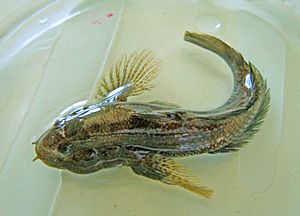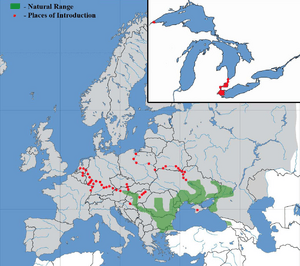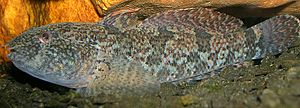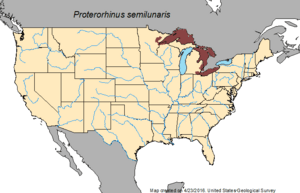Western tubenose goby facts for kids
Quick facts for kids Western tubenose goby |
|
|---|---|
 |
|
| P. semilunaris from the Baraboy River, southern Ukraine | |
| Conservation status | |
| Scientific classification | |
 |
|
| The range of the western tubenose goby. Initial introduction in North America shown, see the map below for further spread. | |
| Synonyms | |
|
The western tubenose goby (Proterorhinus semilunaris) is a type of goby fish. It naturally lives in the fresh waters around the Black Sea and Aegean Sea. Recently, it has spread to Central and Western Europe, and even to North America. In these new places, it is considered an invasive species. This means it is not originally from there and can sometimes cause problems for the local fish.
Scientists once thought the western tubenose goby was the same as another fish, Proterorhinus marmoratus. However, special tests on their DNA showed that they are actually two different species.
Contents
What Does the Tubenose Goby Look Like?
This fish usually grows to about 12.7 centimeters (about 5 inches) long. Its body and head are a bit flat on the sides. It has large, smooth scales called cycloid scales, usually between 37 and 46 of them. Its upper and lower jaws are the same length.
The western tubenose goby does not have a swim bladder, which is an organ that helps fish float. Its head is usually wider than it is tall. Many parts of its body, like its head, neck, and belly, are covered in scales.
The fish is typically brown to yellowish-gray. It has 4 to 5 dark stripes on its back that turn into spots lower down on its body. Its fins often have stripes too.
How is it Different from Other Gobies?
The western tubenose goby has a special feature: its nostrils are shaped like tubes. These tubes extend to its upper lip. This is how it got its name! These tubular nostrils are about 2 to 4 centimeters long.
This feature helps tell it apart from the round goby, which does not have these tubes. The western tubenose goby also lacks a black spot on the back base of its dorsal fin, which is another way to identify it.
Its body is somewhat round, but its underside is flat. It has a wide mouth with large lips and no whiskers (barbels). Its first dorsal fin has 7 or 8 sharp spines. The tail fin is rounded and has a black triangle-shaped spot at its base. Its pelvic fins are joined together, forming a suction cup shape.
Where Does the Tubenose Goby Live?
Natural Home of the Goby
The western tubenose goby is originally from the fresh waters of the Black Sea basin. It also lives in rivers like the Maritsa and Struma that flow into the Aegean Sea. You can find it in parts of the Danube River, from its delta all the way to the Morava River. It also lives in rivers in Bulgaria, like the Kamchiya and Veleka.
It is also found in the Dniester and Southern Bug rivers, and in the Dnieper River up to the Trubizh River. In the Sea of Azov basin, it lives in rivers like the Don and Seversky Donets. It even lives in Lake Neusiedl.
Where the Goby Has Spread

In Europe, this fish has spread to the upper parts of the Danube River, the Dnieper River, and the Rhine-Main system, which connects to the North Sea. It has also been found in the Vistula River. Between 2008 and 2010, it was seen in the Meuse River near the border of Belgium and the Netherlands.
The western tubenose goby arrived in North America, specifically the St. Clair River, likely through Ballast water from ships coming from Eastern Europe. It might have also spread to Canada and the Great Lakes because people used it as live bait. By the early 2000s, it had spread north to the Minnesota-Wisconsin border and east to the New York-Pennsylvania border.

Protecting the Tubenose Goby
In North America, the western tubenose goby is seen as an invasive species. This means it can sometimes harm the local environment. However, in some places where it naturally lives in Europe and Asia, it is considered an endangered species. For example, in Greece, its numbers are decreasing near the town of Serres. This is due to pollution and changes to its natural home caused by humans.
How the Tubenose Goby Lives
Where the Goby Likes to Live
Western tubenose gobies prefer to live in fresh water. They like areas in lakes and rivers that have a lot of plants. They usually stay in shallow water, less than 5 meters deep, where the water moves slowly. They are often found where there are many aquatic plants.
In the Detroit River, these gobies are often found among complex water plants in the fall. They can survive even when there is very little oxygen in the water.
Tubenose gobies build their nests under rocks and logs in shallow water. They are very protective of their nests. Because they prefer these shallow nesting spots, they could potentially live in the shallow parts of all five Great Lakes. While they are not spreading very fast right now, if they do spread more, they could become a threat to the fish that naturally live in the Great Lakes.
What the Goby Eats
The western tubenose goby is an omnivore, meaning it eats both plants and animals. It mostly eats small creatures that live on the bottom of rivers and lakes. These include insect larvae like Chironomidaes, small crustaceans, and copepods.
Gobies also eat the young (larvae) of other fish. This can be a problem for the ecosystems where tubenose gobies live, as they might reduce the number of other fish.
Reproduction and Life Cycle
Female western tubenose gobies can live for up to 5 years. Males usually do not live as long. The males guard their nesting sites to protect their eggs and young fish.
Tubenose gobies lay their eggs under logs and rocks in the shallow fresh waters of the Great Lakes and the rivers that connect them. They can lay eggs multiple times during the warmer months of the year. This means they can have many young fish, making them a very productive species.
While they are not spreading quickly at the moment, their ability to have many young could pose a threat to native fish species like the Rainbow darter and Northern madtom.
Goby's Impact on the Environment
In North America, the western tubenose goby eats many of the same things as native fish like the rainbow darter, northern madtom, and logperch. This means they compete for food, which can make it harder for the native fish to find enough to eat.
Although the western tubenose goby is an invasive species, it has not spread as widely as the round goby. However, it still has the potential to threaten the natural fish species of the Great Lakes. Many native fish that eat other fish (predators) will eat the tubenose goby. This can change the natural food webs in the Great Lakes.
See also
 In Spanish: Proterorhinus semilunaris para niños
In Spanish: Proterorhinus semilunaris para niños


